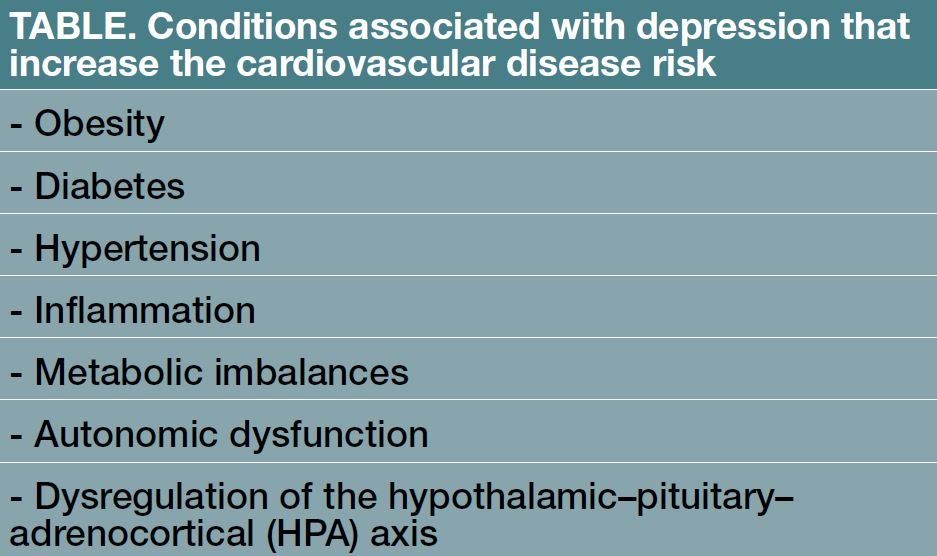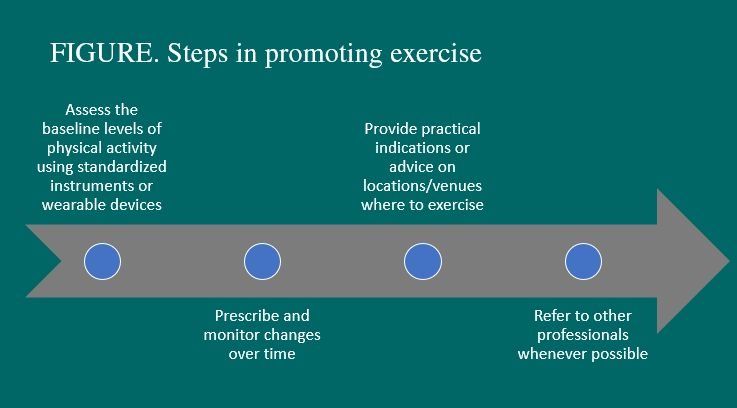Article
Physical Exercise: Lowering Mortality Among Patients With Depression
The premature mortality of individuals with depression is an alarming public health concern. Physical exercise may help address this concern, but it represents an underutilized intervention.

Table. Conditions associated with depression that increase the cardiovascular disease risk

Figure. Steps in promoting exercise

SPECIAL REPORT: ADDRESSING MORTALITY
“People suffering from depression die, on average, 10 years earlier than non-depressed individuals.” You must have heard this while attending a conference, reading a journal, or simply in a discussion with a colleague. It has little to do with the risk of suicide: we are mainly talking about death due to physical causes, and in particular cardiovascular causes. Any mental health professional, upon learning of this fact, may have felt uneasy, even inadequately prepared to address such a complicated issue. After all, until a few years ago, we thought that colleagues from other branches of medicine would take care of those aspects, right? Well, no. A million times, no.
This brief article leverages recent scientific literature to provide some hints as to why premature mortality plagues those who are depressed. It also aims to show the importance of regular physical activity, or even better, physical exercise. Finally, the paper will provide advice on how to encourage patients to do so.
Epidemiological data
The clinical perspective of the individual practicing physician may not always align with epidemiological data. The excess mortality in depressed populations is an apt example. Without delving into a detailed analysis of the literature, there has been a wave of studies showing an alarming phenomenon: given a certain period of observation, a higher rate of people with depression die than those without depression-this appears to be the case for both genders, but especially for males, and for healthy as well as physically ill individuals.
Clearly, it is difficult to account for all factors that may underlie this phenomenon, and this association does not necessarily mean that depression causes death, even if we consider longitudinal studies.1 Nonetheless, depression is consistently associated with conditions that are known to increase the risk of cardiovascular diseases (Table ). More importantly, and arguably more likely to be causally related, individuals with depression tend to engage in unhealthy lifestyles, which are potentially modifiable: unbalanced diet, alcohol use, cigarette smoking, lower adherence to medications, and physical inactivity.
In particular, depressed individuals not only spend less time engaging in physical activity, but they also display sedentary behaviors more commonly than their non-depressed counterparts.2 Ultimately, individuals with depression have low levels of physical fitness, which may not be surprising, but should raise concerns among clinicians because of the implications for mortality. Both muscular strength and cardiorespiratory fitness are meaningful predictors of all-cause mortality and cardiovascular events in men and women.
Exercise may reduce the premature mortality
The epidemiological and experimental evidence showing the wide-ranging beneficial effects of physical activity and exercise for health has proliferated over the past 70 years. Physical activity and exercise are now recognized as fundamental tools for reducing the impact of chronic diseases, especially cardiovascular mortality, as well as improving their course.3
1. Exercise directly improves cardiorespiratory fitness. Randomized trials show that even short bouts of exercise can improve cardiovascular function, in younger as well as older individuals.4
2. Exercise can help manage body weight. The most effective intervention to lose weight remains caloric restriction. Nonetheless, regular exercise can prevent obesity and excess weight and can buffer some of their negative effects.5 This effect seems to depend on improved regulation of appetite hormones and increased metabolic rate.
3. Exercise improves the function of homeostatic systems. The hormonal response to stress, such as the activity of the HPA axis, get fine-tuned by regular exercise and higher cardiorespiratory fitness, showing a blunted response to mild or familiar stressors, and faster recovery.6 Moreover, exercise reduces inflammatory responses and delays the aging of the immune system.7 It also improves the autonomic control of the heart as well as other organs.8
4. Exercise improves metabolism. Randomized clinical trials have shown that exercise improves glycemic control and reduces insulin resistance. Moreover, it improves the lipid profile, by lowering triglycerides and low-density lipoproteins and increasing high-density lipoproteins.9
5. Exercise reduces blood pressure. The antihypertensive effect is greater in individuals who already have hypertension, but it is also observed among healthy people.10
6. Exercise reduces depressive symptoms. Despite some controversies, the antidepressant efficacy of exercise has been established with methodological rigor, and exercise can be prescribed as a treatment for mild-to-moderate depression alone or for severe depression in conjunction with other treatments.11 If depression improves, this may reflect positively on behavioral sequalae, including unhealthy lifestyle.
Currently, only a few lifestyle-related cardiovascular risk factors have not been shown to respond significantly to exercise, namely alcohol consumption and cigarette smoking. Still, early results related to smoking cessation, problem drinking, and substance use among individuals with mental health disorders show promise.12,13
Findings from a meta-analysis of randomized controlled trials indicate that exercise may ultimately have a significant effect on delaying mortality in patients with established coronary heart disease, stroke, heart failure, and diabetes, to an extent that is comparable to that of first-line medications.14 Clearly, enthusiasm for these findings must be tempered by the relative scarcity of available direct head-to-head studies (exercise vs medications), and by the so-called file-drawer bias, whereby negative results may not get published as much as positive ones. On the other hand, however, literature on exercise, compared with other types of interventions, may be less prone to distortions due to financial conflicts of interest.
The clinician may wonder whether evidence from physically ill populations could be directly translated to individuals with depression. Studies pertaining specifically to individuals with depression are not abundant, but preliminary evidence suggests that the benefits of exercise may apply to this population as well. Overall, given the lack of studies directly testing this hypothesis in depressed populations, the evidence is speculative. That said, considering the benefits and the low clinical risks associated with exercise, we believe recommending exercise to patients with depression and physical comorbidities should already be the norm, rather than the exception.
Which exercises are best?
Given the emerging evidence, interventions to improve the lifestyle of patients with depression seems a viable strategy that may ultimately help to reduce mortality risk.15,16 But, how can a clinician achieve this seemingly ambitious goal? How is it possible to promote physical activity in individuals that already suffer a lack of motivation, low sense of physical energy, and reduced initiative as intrinsic symptoms of their condition?
Currently, various recommendations have been proposed for prescribing exercise to individuals with depression, based on either empirical evidence or clinical experience.17-21 The optimal exercise prescription for the treatment of depression is not known, insofar as the relation between the “dose” of exercise (ie, intensity, frequency, duration) and therapeutic response remains mostly unknown. Therefore, recommendations are essentially derived from guidelines that were not specifically developed for depression.22
First, the treating clinician should confront and reassess their own prejudices.11 Physicians are sometimes resistant to the idea of exercise as a possible treatment option, or even as an adjunct intervention. Skepticism may depend on various perceived barriers, including the belief that depressed individuals will not even start to exercise, or that they will soon abandon this activity.23,24 However, especially if good therapeutic alliances exist, many individuals with subthreshold, mild, or moderate depressive symptoms will opt for exercise and will demonstrate satisfactory adherence.25
Second, consider one of the main drivers of any activity: pleasure. Affect-based exercise prescription is an emerging trend in exercise science and may be especially useful for the treatment of depression.26 This method goes beyond the traditional focus of exercise prescriptions, which is maximizing fitness or health gains and minimizing risk, to include the promotion of pleasant affective experiences. The consideration of pleasure as a central element aims to ultimately promote adherence.
In a typical affect-based prescription, the exercise participant is shown a simple rating scale (eg, ranging from +5 or “I feel very good” to -5 or “I feel very bad”) and is instructed to self-regulate their exercise intensity and duration to maintain a rating of +3 (“I feel good”) or higher. Among non-depressed adults, the affective responses to exercise are associated with the amount of physical activity individuals subsequently choose to do.27,28 Even if individuals with depression suffer from symptoms of anhedonia, they may still experience exercise as pleasant and affect-enhancing.29-31
Evidence from studies of depressed individuals shows that the affective responses to a exercise may predict improvement of depressive symptoms and exercise adherence.32,33 This method seems to hold promise for clinical application due to its simplicity, making it appealing to physicians who lack specialized training in exercise and to health care organizations concerned about implementation costs. When recommending exercise to patients, the steps for promoting exercise in non-depressed individuals may prove useful (Figure).34
Third, mental health professionals should not rely only on themselves to prescribe exercise. Exercise interventions can be delivered by professionals with a variety of disciplinary backgrounds, including group exercise leaders, personal trainers, clinical exercise physiologists, wellness specialists, and physical therapists. Group-based exercise that is supervised by a professional is usually associated with lower dropout rates. Given the challenging cognitive and affective features of depression, exercise for individuals with depression should be delivered by professionals with specific experience in mental health care.35 In other words, a well-integrated, collaborative approach is essential.
Conclusions
The premature mortality of individuals with depression is an alarming public health concern. Physical exercise may help address this concern, but it represents an underutilized intervention despite substantial evidence documenting its numerous physical benefits. Exercise can simultaneously tackle several mechanisms that likely lead to premature mortality in this population. Moreover, if it is prescribed, delivered, and supported correctly, exercise can be as effective as other first-line treatments in reducing depressive symptoms, while being mostly free of adverse side-effects.
Disclosures:
Dr Belvederi Murri is Assistant Professor, Department of Neuroscience, University of Ferrara, Parma, Italy; Dr Ekkekakis is Professor, Department of Kinesiology, Iowa State University, Ames, IA. The authors report no conflicts of interest concerning the subject matter of this article.
References:
1. Machado MO, Veronese N, Sanches M, et al. The association of depression and all-cause and cause-specific mortality: An umbrella review of systematic reviews and meta-analyses. BMC Med. 2018;16:1-13.
2. Schuch F, Vancampfort D, Firth J, et al. Physical activity and sedentary behavior in people with major depressive disorder: A systematic review and meta-analysis. J Affect Disord. 2017;210:139-150.
3. Lieberman DE. Is EExercise Really Medicine? An evolutionary perspective. Curr Sports Med Rep. 2015;14:313-319.
4. Magutah K, Thairu K, Patel N. Effect of short moderate intensity exercise bouts on cardiovascular function and maximal oxygen consumption in sedentary older adults. BMJ Open Sport Exerc Med. 2020;6.
5. Ekkekakis P, Vazou S, Bixby WR, Georgiadis E. The mysterious case of the public health guideline that is (almost) entirely ignored: call for a research agenda on the causes of the extreme avoidance of physical activity in obesity. Obes Rev. 2016;17:313-329.
6. Chen C, Nakagawa S, An Y, Ito K, Kitaichi Y, Kusumi I. The exercise-glucocorticoid paradox: how exercise is beneficial to cognition, mood, and the brain while increasing glucocorticoid levels. Front Neuroendocrinol. 2017;44:83-102.
7. Campbell JP, Turner JE. Debunking the myth of exercise-induced immune suppression: redefining the impact of exercise on immunological health across the lifespan. Front Immunol. 2018;9:648.
8. Besnier F, Labrunée M, Pathak A, et al. Exercise training-induced modification in autonomic nervous system: an update for cardiac patients. Ann Phys Rehabil Med. 2017;60:27-35.
9. Lin X, Zhang X, Guo J, et al. Effects of exercise training on cardiorespiratory fitness and biomarkers of cardiometabolic health: a systematic review and meta-analysis of randomized controlled trials. J Am Heart Assoc. 2015;4:1-28.
10. Naci H, Salcher-Konrad M, Dias S, et al. How does exercise treatment compare with antihypertensive medications? A network meta-analysis of 391 randomised controlled trials assessing exercise and medication effects on systolic blood pressure. Br J Sports Med. 2019.
11. Ekkekakis P, Belvederi Murri M. Exercise as antidepressant treatment: time for the transition from trials to clinic? Gen Hosp Psychiatry. 2017;49:A1-A5.
12. Smits JAJ, Zvolensky MJ, Davis ML, et al. The efficacy of vigorous-intensity exercise as an aid to smoking cessation in adults with high anxiety sensitivity: a randomized controlled trial. Psychosom Med. 2016.
13. Patten CA, Bronars CA, Douglas KSV, et al. Supervised, vigorous intensity exercise intervention for depressed female smokers: a pilot study. Nicotine Tob Res. 2017;19:77-86.
14. Naci H, Ioannidis JPA. Comparative effectiveness of exercise and drug interventions on mortality outcomes: metaepidemiological study. Br J Sports Med. 2015;49:1414-1422.
15. Sarris J, O’Neil A, Coulson CE, et. Lifestyle medicine for depression. BMC Psychiatry. 2014;14:1-13.
16. Cairns KE, Yap MBH, Pilkington PD, Jorm AF. Risk and protective factors for depression that adolescents can modify: a systematic review and meta-analysis of longitudinal studies. J Affect Disord. 2014.
17. Baron DA, Lasarow S, Baron SH. Exercise for the treatment of depression. In: Lam LCW, Riba M, Eds. Physical Exercise Interventions for Mental Health. Cambridge: Cambridge University Press; 2016:26-40.
18. Nyström MBT, Neely G, Hassmén P, Carlbring P. Treating major depression with physical activity: a systematic overview with recommendations. Cogn Behav Ther. 2015;44:341-352.
19. Rethorst CD, Trivedi MH. Evidence-based recommendations for the prescription of exercise for major depressive disorder. J Psychiatr Pract. 2013;19:204-212.
20. Stanton R, Happell BM. An exercise prescription primer for people with depression. Issues Ment Health Nurs. 2013;34:626-630.
21. Stanton R, Reaburn P. Exercise and the treatment of depression: a review of the exercise program variables. J Sci Med Sport. 2014;17:177-182.
22. Garber CE, Blissmer B, Deschenes MR, et al. Quantity and quality of exercise for developing and maintaining cardiorespiratory, musculoskeletal, and neuromotor fitness in apparently healthy adults: guidance for prescribing exercise. Med Sci Sports Exerc. 2011;43:1334-1359.
23. Searle A, Calnan M, Turner KM, et al. General practitioners’ beliefs about physical activity for managing depression in primary care. Ment Health Phys Act. 2012.
24. Stanton R, Franck C, Reaburn P, Happell B. A pilot study of the views of general practitioners regarding exercise for the treatment of depression. Perspect Psychiatr Care. 2014.
25. Searle A, Calnan M, Lewis G, et al. Patients’ views of physical activity as treatment for depression: a qualitative study. Br J Gen Pract. 2011.
26. Ladwig MA, Hartman ME, Ekkekakis P. Affect-based exercise prescription: an idea whose time has come? ACSMs Health Fit J. 2017;21:10-15.
27. Rhodes RE, Kates A. Can the affective response to exercise predict future motives and physical activity behavior? A systematic review of published evidence. Ann Behav Med. 2015;49:715-731.
28. Williams DM, Dunsiger S, Miranda R, et al. Recommending self-paced exercise among overweight and obese adults: a randomized pilot study. Ann Behav Med. 2015;49:280-285.
29. Mata J, Hogan CL, Joormann J, et al. Acute exercise attenuates negative affect following repeated sad mood inductions in persons who have recovered from depression. J Abnorm Psychol. 2013;122:45-50.
30. Mata J, Thompson RJ, Jaeggi SM, et al. Walk on the bright side: physical activity and affect in major depressive disorder. J Abnorm Psychol. 2012;121:297-308.
31. Weinstein AA, Deuster PA, Francis JL, et al. The role of depression in short-term mood and fatigue responses to acute exercise. Int J Behav Med. 2010;17:51-57.
32. Rethorst CD, South CC, Rush AJ, et al. Prediction of treatment outcomes to exercise in patients with nonremitted major depressive disorder. Depress Anxiety. 2017;34:1116-1122.
33. Suterwala AM, Rethorst CD, Carmody TJ, et al. Affect following first exercise session as a predictor of treatment response in depression. J Clin Psychiatry. 2016;77:1036-1042.
34. Lobelo F, Rohm Young D, Sallis R, et al. Routine assessment and promotion of physical activity in health care settings: a scientific statement from the American Heart Association. Circulation. 2018.
35. Rosenbaum S, Hobson-Powell A, Davison K, et al. The role of sport, exercise, and physical activity in closing the life expectancy gap for people with mental illness. J Am Coll Sport Med. 2018;3:72-73.






